| Listing 1 - 10 of 138 | << page >> |
Sort by
|
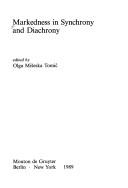
ISBN: 3110117800 3110862018 9783110117806 Year: 1989 Volume: 39 Publisher: Berlin: Mouton de Gruyter,
Abstract | Keywords | Export | Availability | Bookmark
 Loading...
Loading...Choose an application
- Reference Manager
- EndNote
- RefWorks (Direct export to RefWorks)
No detailed description available for "Markedness in synchrony and diachrony".
Book
Abstract | Keywords | Export | Availability | Bookmark
 Loading...
Loading...Choose an application
- Reference Manager
- EndNote
- RefWorks (Direct export to RefWorks)
Handelt es sich bei dem Mitgliederschwund deutscher Volksparteien um ein unaufhaltsames Niedergangsszenario oder um ein umkehrbares Phänomen? In einer ersten systematischen Untersuchung der Strategien der CDU und SPD bei der Anwerbung neuer Parteimitglieder zeigt Jakobs, dass es sich lohnt, in ein völlig neues Forschungsfeld vorzudringen. Die vergleichende Analyse macht deutlich, dass der Mitgliederverlust in deutschen Parteien zwar gestoppt werden kann, aber die weitere Professionalisierung der Parteimitglieder notwendig macht. Is the loss of members of German popular parties an unstoppable scenario of decline or a reversible phenomenon? The first systematic research shows in a comparative analysis of the strategies of the German parties CDU and SPD in recruiting new party members that it is worthwhile to enter a completely new field of investigation. The study reveals that the loss of members can be stopped at the cost of further professionalization of party members. Simon Jakobs' Band zur "Neumitgliederwerbung von SPD und CDU im Vergleich" ist vorbildlich für alle, die eine wissenschaftliche Arbeit verfassen wollen und nützlich für die, die schnell und sicher eine Übersicht zum Stand der Forschung über die Mitgliederfrage suchen. Er kann auch den Praktikern empfohlen werden, die die organisatorischen Voraussetzung ihrer Partei verbessern wollen, um Mitglieder zu gewinnen. Das Buch könnte wegweisend für alle Parteienforscher sein, die die Folgen der widersprüchlichen komplexen Aufgaben von Parteien im Kontext demokratischer Gesellschaften besser verstehen wollen. Darüber hinaus ist die Lektüre ein Gewinn für alle, die sich für intellektuelle Herausforderungen begeistern können.ZParl, 3/2021Simon Jakobs Band zur "Neumitgliederwerbung von SPD und CDU im Vergleich" ist vorbildlich für alle, die eine wissenschaftliche Arbeit verfassen wollen und nützlich für die, die schnell und sicher eine Übersicht zum Stand der Forschung über die Mitgliederfrage suchen. Er kann auch den Praktikern empfohlen werden, die die organisatorischen Voraussetzung ihrer Partei verbessern wollen, um Mitglieder zu gewinnen. Das Buch könnte wegweisend für alle Parteienforscher sein, die die Folgen der widersprüchlichen komplexen Aufgaben von Parteien im Kontext demokratischer Gesellschaften besser verstehen wollen. Darüber hinaus ist die Lektüre ein Gewinn für alle, die sich für intellektuelle Herausforderungen begeistern können.Rezensiert von Ingrid Reichart-Dreyer im Februar 2021
Freiwilligenarbeit --- member recruitment --- membership --- Mitgliederrekrutierung --- Mitgliederwerbung --- participation --- Partizipation --- popular parties --- recruitment strategy --- Recruitmentforschung --- Recruitmentstrategien --- Strategie --- Volksparteien --- volunteer work
Book
ISBN: 0429263732 0367208431 9780429263736 9780429563232 042956323X 9780429558764 0429558767 9780429554292 042955429X 9780367208431 Year: 2020 Publisher: Taylor & Francis
Abstract | Keywords | Export | Availability | Bookmark
 Loading...
Loading...Choose an application
- Reference Manager
- EndNote
- RefWorks (Direct export to RefWorks)
"Written from a pan-European perspective, this book examines the decision-making processes in immigration and integration policies in Europe across decades focusing in on several key moments of Europe's post-war history. The analysis of factors taken into consideration by states in key moments of immigration policy (re)formulation shows that Europe is moving away from rational, economic arguments towards more political ones. This book contributes to the theoretical and practical debate regarding immigration and integration policies by arguing that - contrary to assumptions - immigration policy should not be treated as having precedence before integration policy. It also reflects on the growing anti-immigration sentiments as well as securitization and criminalization of migration issues that are fuelled by right-wing politics. This book will be of key interest to students and scholars of migration, the European Union, European integration, social policy, public policy, international relations, European studies, law, economics, sociology and to professionals, policy-makers, think tanks and associations in NGOs, the EU and other IOs"--
Politics & government --- European Union countries --- Emigration and immigration --- Government policy. --- EU --- Europe --- Challenges --- Duszczyk --- Immigration --- integration --- Maciej --- Member --- Opportunities --- Perspectives --- Policies --- Relations --- Selected --- States
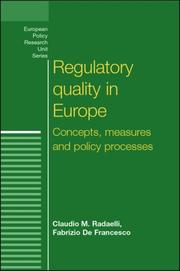
ISBN: 9781847792310 1847792316 9780719074042 0719074045 1781701571 9781781701577 Year: 2007 Publisher: Manchester : Manchester University Press,
Abstract | Keywords | Export | Availability | Bookmark
 Loading...
Loading...Choose an application
- Reference Manager
- EndNote
- RefWorks (Direct export to RefWorks)
The European Union and its member states are investing in ambitious programmes for 'better regulation' and targets of regulatory quality. This book lifts the veil of excessively optimistic propositions covering the whole better regulation agenda. It provides an innovative conceptual framework to handle the political complexity of regulatory governance. It approaches better regulation as an emerging public policy, with its own political context, actors, problems, rules of interaction, instruments, activities and impacts. Focusing on the key tools of impact assessment, consultation, simplificati
Administrative procedure --- European Union. --- better regulation. --- consultation. --- impact assessment. --- member states. --- public policy. --- regulatory governance. --- regulatory quality. --- rules of interaction. --- simplification.
Book
ISBN: 1781701636 1847792375 9781847792372 9781781701638 9780719078828 0719078822 Year: 2008 Publisher: Manchester, U.K. ; New York : New York : Manchester University Press ; Distributed exclusively in the USA by Palgrave MacMillan,
Abstract | Keywords | Export | Availability | Bookmark
 Loading...
Loading...Choose an application
- Reference Manager
- EndNote
- RefWorks (Direct export to RefWorks)
Can Russia, the European Union and the three major EU member states adopt a unified policy line in the global arena? Charlotte Wagnsson investigates the cohesiveness of 'greater Europe' through the detailed scrutiny of policy statements by the leadership elites in the UK, France, Germany, Russia and the EU in connection with three defining events in international security: the crisis in Kosovo of 1999; the terrorist attacks of 9/11 and the Iraq crisis of 2003. This extensive empirical enquiry results in a critical constructivist response to neorealist understandings of European security. The b
Security, International --- 9/11. --- EU member states. --- European Union. --- Iraq. --- Kosovo. --- Russia. --- greater Europe. --- international security. --- leadership elites. --- policy statements. --- terrorist attacks.
Book
ISBN: 9781547400270 1547400277 1547400382 1547416440 Year: 2018 Publisher: Boston ; Berlin : De|G Press,
Abstract | Keywords | Export | Availability | Bookmark
 Loading...
Loading...Choose an application
- Reference Manager
- EndNote
- RefWorks (Direct export to RefWorks)
Boards of directors are sitting ducks. Shareholders complain and even attack, management manipulates, and individual board members have little power, able to act only as part of the board as a whole. Governance issues are front and center, yet there is often little understanding, even among board members, of the key role that they play. Written in an accessible and human voice, The Governance Revolution: What Every Board Member Needs to Know, NOW! provides information and context essential to anyone seeking to understand how corporations and their stewards-the board of directors-can and should function in the volatile world we inhabit. Deborah Hicks Midanek offers useful insight into what board members of corporations actually do, the current standards for board members and why they exist. She includes a timely discussion of how clarity of purpose can improve board and director effectiveness. Informed by her long experience serving public, private, and family owned corporate boards as well as those of charitable, and government organizations, she provides essential context regarding the evolution of board practice as well as candid discussion of the issues involved in the relentless effort to improve corporate governance processes. Focused mainly on the dominant public corporation, she also explores the special challenges of serving private and family owned as well as nonprofit and public agency boards. Written by a seasoned board member, and liberally laced with stories and cases illustrating the tricky issues directors wrestle with, this book is the essential common-sense companion for anyone working with a board, serving on a board, or wanting to do so. Directors, aspiring directors, investors, and students of corporate behavior will benefit from this highly readable description of the cloistered boardroom. For Roger Trapp's article in Forbes featuring a discussion of this title click here https://www.forbes.com/sites/rogertrapp/2018/10/22/independent-directors-nehttps://www.forbes.com/sites/rogertrapp/2018/10/22/independent-directors-need-to-stand-up-to-activists/#7060008826b0ed-to-stand-up-to-activists/#7060008826b0 For a Roundtable discussion in Financier Worldwide Magazine featuring Deborah Hicks Midanek please click here https://www.financierworldwide.com/roundtable-risks-facing-directors-officers-aug18#.W1BqQdVKiUk Click here for a review in Financial Analysts Journal https://www.cfapubs.org/doi/abs/10.2469/br.v13.n1.10
Boards of directors --- Corporate governance --- Governance, Corporate --- Industrial management --- Directors of corporations --- Boards of supervision (Corporation law) --- Associations, institutions, etc. --- E-books --- Corporate governance. --- Boards of directors. --- Board Member. --- Board of Directors. --- Board. --- CEO. --- Director. --- Governance.

ISBN: 0521839629 9780521839624 9780511486388 9780521142236 0511241623 9780511241628 9780511242359 0511242352 0511240589 9780511240584 0511241100 9780511241109 0511486383 9786610568062 6610568065 1107162556 1280568062 0511318456 0521142237 Year: 2006 Publisher: Cambridge ; New York : Cambridge University Press,
Abstract | Keywords | Export | Availability | Bookmark
 Loading...
Loading...Choose an application
- Reference Manager
- EndNote
- RefWorks (Direct export to RefWorks)
'Markedness' refers to the tendency of languages to show a preference for particular structures or sounds. This bias towards 'marked' elements is consistent within and across languages, and tells us a great deal about what languages can and cannot do. This pioneering study presents a groundbreaking theory of markedness in phonology. De Lacy argues that markedness is part of our linguistic competence, and is determined by three conflicting mechanisms in the brain: (a) pressure to preserve marked sounds ('preservation'), (b) pressure to turn marked sounds into unmarked sounds ('reduction'), and (c) a mechanism allowing the distinction between marked and unmarked sounds to be collapsed ('conflation'). He shows that due to these mechanisms, markedness occurs only when preservation is irrelevant. Drawing on examples of phenomena such as epenthesis, neutralisation, assimilation, vowel reduction and sonority-driven stress, Markedness offers an important insight into this essential concept in the understanding of human language.
Grammar, Comparative and general --- Markedness (Linguistics) --- Marked member (Linguistics) --- Distinctive features (Linguistics) --- Generative grammar --- Linguistics --- Phonology --- Phonetics --- Phonology. --- Arts and Humanities --- Language & Linguistics --- Philology --- Grammar, Comparative and general Phonology
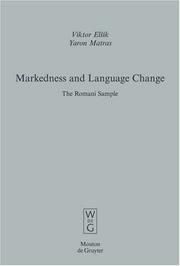
ISBN: 3110184524 9783110184525 3110197596 9783110197594 1282193961 9786612193965 9781282193963 Year: 2006 Publisher: Berlin ; New York : Mouton de Gruyter,
Abstract | Keywords | Export | Availability | Bookmark
 Loading...
Loading...Choose an application
- Reference Manager
- EndNote
- RefWorks (Direct export to RefWorks)
'Markedness' is a central notion in linguistic theory. This book is the first to provide a comprehensive survey of markedness relations across various grammatical categories, in a sample of closely-related speech varieties. It is based on a sample of over 100 dialects of Romani, collected and processed via the Romani Morpho-Syntax (RMS) Database - a comparative grammatical outline in electronic form, constructed by the authors between 2000-2004. Romani dialects provide an exciting sample of language change phenomena: they are oral languages, which have been separated and dispersed from some six centuries, and are strongly shaped by the influence of diverse contact languages. The book takes a typological approach to markedness, viewing it as a hierarchy among values that is conditioned by conceptual and cognitive universals. But it introduces a functional-pragmatic notion of markedness, as a grammaticalised strategy employed in order to priositise information. In what is referred to as 'dynamic', such prioritisation is influenced by an interplay of factors: the values within a category and the conceptual notions that they represent, the grammatical structure onto which the category values are mapped, and the kind of strategy that is applied in order to prioritise certain value. Consequently, the book contains a thorough survey of some 20 categories (e.g Person, Number, Gender, and so on) and their formal representation in various grammatical structures across the sample. The various accepted criteria for markedness (e.g. Complexity, Differentiation, Erosion, and so on) are examined systematically in relation to the values of each and every category, for each relevant structure. The outcome is a novel picture of how different markedness criteria may cluster for certain categories, giving a concrete reality to the hitherto rather vague notion of markedness. Borrowing and its relation to markedness is also examined, offering new insights into the motivations behind contact-induced change.
Markedness (Linguistics) --- Romani language --- Gypsy language --- Romany language --- Rommany language --- Indo-Aryan languages, Modern --- Romanies --- Marked member (Linguistics) --- Distinctive features (Linguistics) --- Generative grammar --- Grammar, Comparative and general --- Linguistics --- Dialects --- Markedness --- Languages --- Markedness. --- Dialects. --- Language Change. --- Romani language.
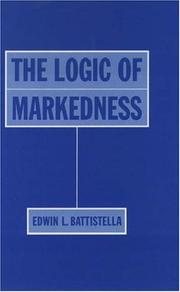
ISBN: 1280528737 019535592X 1429406712 9781429406710 9781280528736 0195103947 9780195103946 0197722016 Year: 1996 Publisher: New York : Oxford University Press,
Abstract | Keywords | Export | Availability | Bookmark
 Loading...
Loading...Choose an application
- Reference Manager
- EndNote
- RefWorks (Direct export to RefWorks)
This work studies the concept of markedness in the Prague School structuralism of Roman Jakobson, its importation into generative linguistics and its development in Chomsky's "principles and parameters" framework. It traces how structuralist and generative linguistics have drawn on the concept.
Markedness (Linguistics) --- Marked member (Linguistics) --- Distinctive features (Linguistics) --- Generative grammar --- Grammar, Comparative and general --- Linguistics --- Chomsky, Noam --- Jakobson, Roman, --- Contributions in markedness. --- Chomsky, Noam. --- Jakobson, Roman --- Chomsky, Abraham Noam --- Markedness (Linguistics). --- Jakobson, Roman Osipovič --- Jakobson, R.O.
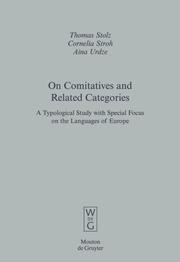
ISBN: 1282194011 9786612194016 3110197642 9783110197648 9783110185874 3110185873 9781282194014 Year: 2006 Publisher: Berlin ; New York : Mouton de Gruyter,
Abstract | Keywords | Export | Availability | Bookmark
 Loading...
Loading...Choose an application
- Reference Manager
- EndNote
- RefWorks (Direct export to RefWorks)
This is the first book-length functional-typologically inspired crosslinguistic study of comitatives and related categories such as the instrumental. On the basis of data drawn from 400 languages world-wide (covering all major phyla and areas), the authors test and revise a variety of general linguistic hypotheses about the grammar and cognitive foundations of comitatives. Three types of languages are identified according to the morphological treatment of the comitative and its syncretistic association with other concepts. It is shown that the structural behaviour of comitatives is areally biassed and that the languages of Europe tend to diverge from the majority of the world's languages. This has important repercussions for a language-independent definition of the comitative. The supposed conceptual closeness of comitative and instrumental is discussed in some detail and a semantic map of the comitative is put forward. Markedness is the crucial concept for the evaluation of the relation that ties comitatives and instrumentals to each other. In a separate chapter, the diachrony of comitatives is looked into from the perspective of grammaticalisation research. Throughout the book, the argumentation is richly documented by empirical data. The book contains three case-studies of the comitative in Icelandic, Latvian and Maltese - each of which represents one of the three language types identified earlier in the text. For the purpose of comparing the languages of Europe, a chapter is devoted to the analysis of a large parallel literary corpus (covering 64 languages) which reveals that the parameters of genetic affiliation, areal location and typological classification interact in intricate ways when it comes to predicting whether or not two languages of the sample behave similarly as to the use to which they put their comitative morphemes. With a view to determining the degree of similarity between the languages of the European sub-sample, methods of quantitative typology are employed. General linguists with an interest in case, functional typologists, grammaticalisation researchers and experts of markedness issues will value this book as an important contribution to their respective fields of interest. We regret that, due to a PDF problem, the figure on page 111 is partly shown in black. Please find the correct table here.
Grammar, Comparative and general --- Markedness (Linguistics) --- Typology (Linguistics) --- Language and languages --- Linguistic typology --- Linguistics --- Linguistic universals --- Grammaticalization --- Semantics --- Marked member (Linguistics) --- Distinctive features (Linguistics) --- Generative grammar --- Case --- Case. --- Grammaticalization. --- Typology --- Classification --- Syntax --- Europe --- Languages. --- Grammar --- Philology --- Language Typology. --- Possessive constructions.
| Listing 1 - 10 of 138 | << page >> |
Sort by
|

 Search
Search Feedback
Feedback About UniCat
About UniCat  Help
Help News
News